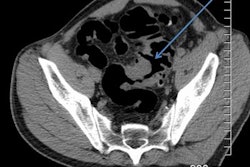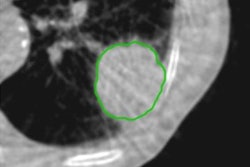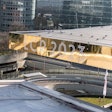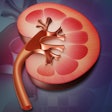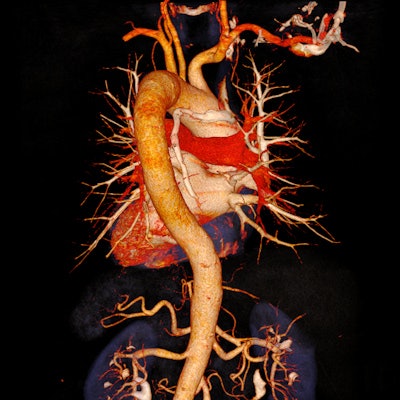
Of all the major imaging modalities on show in the exhibition halls at ECR 2017, it's arguable that none have undergone such transformation over the last decade as CT. Following a rapid rise to prominence as a workhorse tool for radiology in the early 21st century, safety concerns and the increasing use of MRI and ultrasound in a wider array of applications, CT has had to reinvent itself.
The latest CT offerings provide greatly improved imaging capability, but also automatic dose-monitoring with smart dose protocols, much quicker scan speeds, and a wider range of systems to cater for all provider types.
Additionally, the application of CT continues to expand as is evident in many of the clinical symposia held at ECR 2017. CT is diversifying, with use in radiotherapy planning and tracking treatment response, CT colonography and lung cancer detection (with low-dose scanning protocols). It continues also to be merged with other modalities (PET/CT, CT-interventional x-ray labs), and is even forging into quantitative imaging and radiomics with spectral dual energy CT.
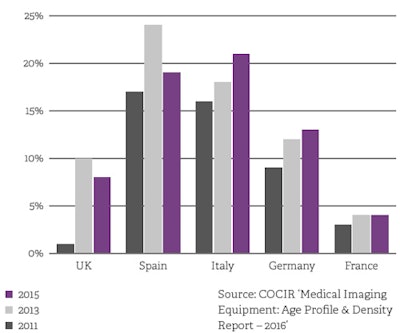 Percentage of CT systems installed aged 10 years or older; select European countries.
Percentage of CT systems installed aged 10 years or older; select European countries.While these advances point to an assured role for CT in the future of radiology and have allowed greater access efficiency and safety of CT use, the lag between the exhibition floor and everyday use in European hospitals appears to be widening.
A recent European Coordination Committee of the Radiological, Electromedical and Healthcare IT Industry (COCIR) survey of European countries has shown that in the past five years the age profile of CT system installed base has worsened, while other advanced imaging modalities such as MRI and cathlabs have remained stable. More than half of currently installed CT systems are 6 years old or older and, more alarmingly, the number of countries with 10% of their CT systems older than 10 years has trebled in the last seven years.
If we consider many improvements in CT dose modulation and monitoring have come to market in the last decade, then a significant proportion of currently installed systems still in use today are a long way from the safety and clinical standard on show today.
So what can be done?
There is no easy fix. Health budgets are under scrutiny and control, and the current economic picture for Europe does not suggest this will change anytime soon. In addition, radiologist numbers in Europe continue to slowly decline, further limiting the momentum for a significant push to renew the aging installed base. That said, there are some developments that can help ease the situation.
 Stephen Holloway is principal analyst and company director at Signify Research.
Stephen Holloway is principal analyst and company director at Signify Research.Firstly, a wider choice of competent but lower-cost CT is now available. These systems boast many technical, efficiency, and safety benefits over systems a decade old. Moreover, with healthcare analytics more commonplace, the ability to calculate return on investment versus legacy systems is getting easier for providers. Alternatively, the major CT vendors are also wiser to the potential value to customers of refurbished systems and now offer certified, high-quality refurbished systems with attractive warranty and service options.
Other options are coming to the fore. Cone-beam CT (CBCT) for extremity imaging has been recently unveiled and use of CBCT for head trauma for emergency medicine is expected to follow soon. While currently priced equivalent to conventional midrange CT systems, CBCT may offer a lower cost option to conventional CT and handle a significant proportion of CT procedures soon.
The business model for procurement is also evolving. Capital expenditure models are predicted to slowly transition toward a mixture of managed services and risk-sharing partnerships between vendors and providers. This will certainly not happen overnight, as this requires a major overhaul of current public and private healthcare funding. However, with a greater focus on efficiency, cost control, and operational analytics, we should expect to see more focus on the longer-term benefits of newer CT technology, rather than the short-term focus on up-front system cost.
Editor's note: The CT image used to introduce this article on our home page consists of a CT angiogram of the aorta at low kV and high mAs with High Power 80 for iodine contrast and potential reduction of required contrast media dosage (tube current = 80 kV/375 mAs, CTDIvol = 3.45 mGy, dose length product = 147 mGy-cm). Provided by University Hospital of Erlangen, Germany, and Siemens Healthineers.
Originally published in ECR Today on 3 March 2017.
Copyright © 2017 European Society of Radiology





